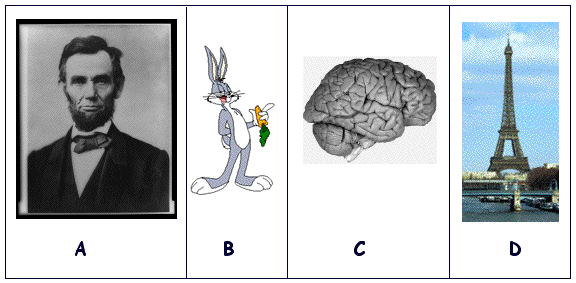Return to MODULE PAGE
Introduction to Perception (Page 1)
Rob Stufflebeam: Author
The aim of the cognitive and learning sciences is to understand the nature and workings of intelligent systems, both natural and artificial. Again, an intelligent system is something that processes internal information in order to do something purposeful. Humans are intelligent systems, as are rabbits, roaches, robots, and countless other types of things. Consequently, there are many aspects of intelligent systems studied by cognitive scientists. One of them is perception.
Sensation vs. perception
But what is perception? Rather than give you a textbook definition, it will be better for you to see for yourself. Hence, let me have you perform a little experiment. There are 4 images below, A — D, each depicting a particular object. Your task here is to report what those objects are. Report your observations out loud in the form of the following statements:
"Object A is . . . ."
"Object B is . . . ."
"Object C is . . . ."
"Object D is . . . ."
Begin.

Did you have any trouble identifying what these images represent? Probably not. So, what did you report? Any of the following responses (among others) are acceptable:
|
Object A is . . . |
a photo of Abraham Lincoln. a photo of the 16th President of the United States. an image of the guy who is depicted on the U.S. five dollar bill. a black-and-white photograph of a famous bearded gentleman. |
| Object B is . . . |
a picture of Bugs Bunny. a picture of a cartoon character holding a partially eaten carrot. a picture of Elmer Fudd’s nemesis. a color picture. |
| Object C is . . . |
a photograph of the human brain. a photo of the right hemisphere, cerebellum, and spinal cord. a photo of the most important organ in the human body. a black-and-white photo of the cerebral cortex and other structures. |
| Object D is . . . |
a photo of the Eiffel Tower. a photo of a famous Paris landmark. a photo of the Seine River with the Eiffel Tower in the background. a color photo taken in Paris, France. |
Because you have been recognizing faces, people, places, animals, objects, and events for as long as you can remember, there is a sense in which your task in this "experiment" was rather easy. And what this experiment illustrates is your ability to perceive. Specifically, it illustrates your ability to see something in your environment, to be aware of it, and to recognize it -- to see something as a thing of a certain sort. Without the awareness of what you are seeing, you are only visually sensing your environment, not perceiving it. The difference between "seeing" and "seeing as" is the difference that makes the difference between vision (sensation) and visual perception. They are not the same thing.
For example, direct your attention to the image of Bugs Bunny below. What do you see?





